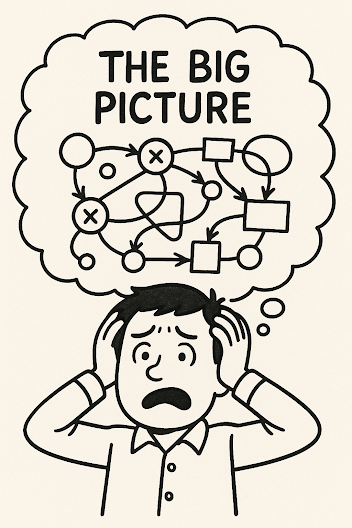Event Storming is a powerful technique that helps you learn a lot, but I always emphasize — both in my daily work and in the trainings I conductc — that you need to ensure there is a return on investment in everything you do. That’s why I want to remind you of a few things you should keep in mind as a workshop facilitator, so you don’t end up with just an entertaining session that delivers little value.
Remember what the goal is
Your goal is not precision or completeness. The real objective is to gain a deeper understanding, spread knowledge within the group, and ensure that everyone understands terms and concepts in the same way. This is crucial, and it’s worth reminding the group about it from time to time.
People often seek closure: all questions answered, a fully drawn picture, etc. Yet, during a big picture workshop, this almost never happens. You actually want to uncover complexity, reveal ambiguities, ask questions, and discover challenges and unknowns.
By reminding the group of this, you create comfort around the idea that it’s perfectly fine to end the session with more questions than answers. First, because you finally know what the questions are, and second, because everyone understands them in the same way.
You may not have enough time… and that’s okay
Time for your workshop is not unlimited, and importantly, in some situations, you might not get another chance to run a follow-up session with the same group.
You need to keep this in mind because there can be a lot to cover and many events to discuss. With all this information on the wall, you need to use as many time-saving tools as possible. Yet even then, you still might not have enough time for everything. That’s why it’s crucial to start and continue with the most important events. This way, even if time doesn’t allow you to discuss everything, at least you’ll cover what matters most.
Additionally, share this information with the group. Assure them that if there are sticky notes left unordered or undiscussed, it doesn’t mean you failed to achieve your goal. The goal is to learn and understand more—not everything. And the more complex the domain, the more events might remain unaddressed.
Events are more important than anything else
During chaotic exploration and later during enforcing the timeline, you learned there are plenty of things you can add to the wall: actors, systems, and more. However, remember that events are the most essential. All other elements orbit around them and appear on the board thanks to discussions about events. Events drive the action, and that’s why they are the most important in our business.
This the reason I recommended adding additional information when needed and noticed, not as a dedicated step. By doing so, you can save a lot of time.
Focus on hotspots, not resolutions
We want to exchange information and build a common understanding; we want to enable collaboration and discussion. On the other hand, we have to stay on track with time. That’s why I recommend using the 2-minute rule, especially during big picture workshops covering a broad business scope. If you can’t resolve a problem, question, or challenge quickly, simply write a hotspot, stick it to the wall, and move on. The picture is big — you don’t want to get stuck discussing one sticky note.
Too many details are your enemy
Too much or too little detail is extremely subjective, and that’s what makes this point tricky. As a facilitator, sometimes you have to make the call based on your intuition. Instead of diving into details, just place a hotspot on the wall with a question or unfinished conclusion.
How do you know if the discussion is getting too detailed?
Observe the group — if everyone except one or two people looks bored, take it as a warning sign.
Is the discussion about a pivotal event? For example, if the event “Trainer Skills Verified” is on the wall, you probably don’t need to discuss each step of that assessment.
Is the group exploring an already named concept? For instance, if you know you need “Personal Data” to sign an agreement with a trainer, you don’t have to list every single piece of information that makes up personal data.
Things may change… and that’s fine
If the goal is not precision or completeness, it’s very likely there will be mistakes on the timeline you create. Later on, some things will evolve, some will be discarded, and new things will appear. Our understanding will grow over time, with each session and each decision. When we learn more, it’s natural to notice flaws in our previous understanding.
This is not a problem to be solved; it’s simply a characteristic of the big picture workshop. It provides a solid foundation for future discussions and actions.
Summary
Most of what I wrote above highlights why it’s so important to keep track of time and to remind everyone of the workshop’s goal — we want to learn as much as possible about everything. But remember: it won’t be perfect, and we don’t want it to be. This workshop is about building a better understanding of what we’re going to work with.
Final thought
Of course, sometimes you don’t have to worry about time. You, as the facilitator, are the one to make that call. Sometimes it’s worth guiding the group through each step of the big picture and letting them have all the discussions they want. Maybe the number of events isn’t overwhelming, or you can extend the session or schedule another one. Observe, adapt, review, and repeat.


No comments:
Post a Comment